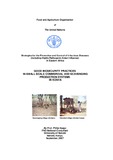| dc.description.abstract | Although Kenya is on the migratory flyway for birds flying from Siberia through the Middle
East and moving along the great Rift Valley to Southern Africa, it has not yet experienced avian
influenza infection. However, the risks of exposure are very high given the fact that outbreaks
have and continue to occur in Egypt which lies directly along this flyway
and that Kenya has very many wetlands where migratory birds can land. It is therefore
appropriate to assess the possible bio-security flaws that may arise in the more vulnerable poultry
production systems of sectors 3 and 4. In this regard FAO commissioned a study of the Kenya
poultry sector analysis to identify the potential bio-security risks and lay a basis for developing
guidelines for bio-security interventions.
Biosecurity principles include simple procedures and practices which when applied prevent entry
of disease agents into a farm or the exit of the disease agent from infected premises. This may
involve protocols, practices, and manouvres to ensure that clean flocks remain free from entry of
disease agents and that disease agents remain confined in infected flocks and do not spread to
other premises. It includes controlling movement of stock, persons, equipment and products into
the clean farm and out of infected premises; and finally it involves methods that enable farm to
remain in a state of sustained cleanliness, referred to as sanitation.
Commercial layer and broiler chicken farmers obtain their day old chicks from in-country
hatcheries while farmers keeping indigenous chickens source their original breeding stock from a
neighbour or from the market. Currently it is easy to obtain broiler day old chicks but one has to
wait for at least eight months after booking to get layer chicks. Importation of day old chicks
from infected countries has been banned. This has disrupted placement programmes of the local
hatcheries since they are unable to import day old chicks from the traditional sources that they
are used to. While some of the houses in sector 3 are made of washable walls and floors, most of
the houses in sector 4 are difficult to clean and decontaminated.
The broiler and layer chicken houses should conform to the ideal recommendations given above.
However, the important point to remember is that the house should be cleanable easily; should
reduce wind chill and provide adequate ventilation, sunshine and sunlight. Laying boxes should
be provided. The houses should facilitate parasite and disease control.
They should promote faster growth and protect the chicken from predatory birds and animals and
adverse weather conditions and theft during the night as well as during the day time. On the other
hand houses in sector 4 vary very markedly. However, irrespective of the type of house they
should observe some minimal criteria, namely: the houses must have enough space for the
number of birds to be kept in the house so as to avoid over-crowding and other vices that
emanate from crowding; the houses should kept dry, clean and well ventilated; and the should
have adequate sunshine and lighting.
Whether the farmers keep commercial or indigenous chicken, they should be conversant with the
best methods that promote safety, good growth and optimal productivity of the chicken. This
would also create awareness of the possible flaws that may occur if improper husbandry
practices are done. One of the greatest break-throughs in dealing with bio-security issues will
occur when a farmer realizes that what he or she has been convinced about in the past to be a
very good and correct manner of raising their birds actually predisposes not only the flock but
also the farmer and his whole household to disease. The farmer will have reached a turning point
towards good husbandry practices. But this will take a lot of careful teaching and training using a
language the farmer can identify with and relate to his or her daily life. While the feeds for
commercial birds is generally good in quality and the supplies are adequate, the indigenous
chickens scavenge for their own food in the environment and they are more likely to get sick
from disease agent brought about by wild birds or animals. The feed would be a source of
disease to the commercial birds if it was itself contaminated with the disease agent.
Commercial layer and broiler flock are routinely vaccinated against common diseases found in
the country. However, most indigenous chickens are not vaccinated except in areas where special
programmes have been run that show the farmers the value of protecting birds from disease and
the ensuing increases in productivity. Newscastle disease has been used as an example in some
villages of one location where those who vaccinated their birds did not loose any of their birds
while the disease wiped out all the chickens in the villages that did not vaccinate. There were
many bio-security flaws identified at different points along the value chain from the farm to the
consumer where disease could be spread between birds and to humans. Live bird markets,
slaughter houses and dry and wet methods of plucking feathers were particularly weak areas
likely to lead to disease spread. Disposal of manure, dead birds and slaughter waste are other
areas to be looked at carefully. Persons constantly exposed to high concentrations of poultry dust
and aerosol, for example those in live bird markets, slaughter houses, poultry houses and meat
processing handling poultry were identified as being at high risk of contracting avian influenza
disease. Simple procedure like washing hands and personal hygiene will reduce chances of
getting infected | |

